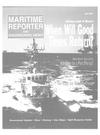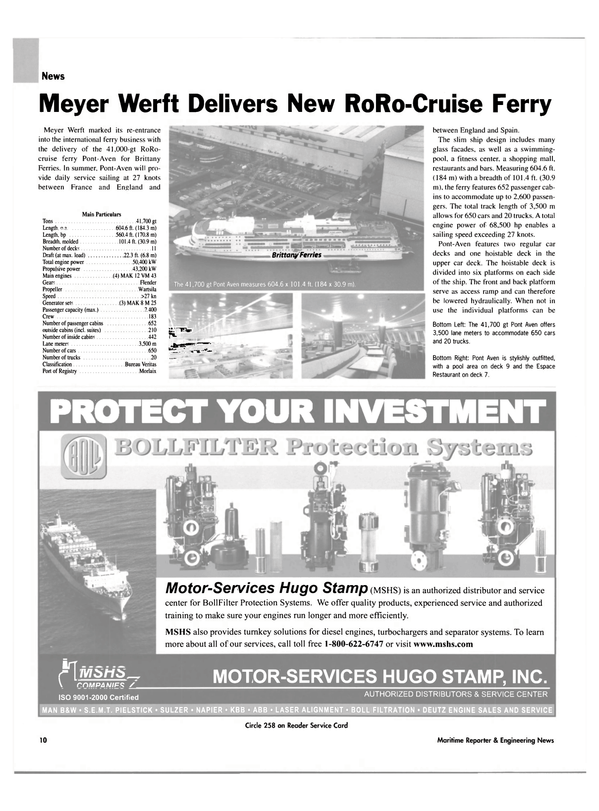
Meyer Werft Delivers New RoRo-Cruise Ferry
Meyer Werft marked its re-entrance into the international ferry business with the delivery of the 41,000-gt RoRocruise ferry Pont-Aven for Brittany Ferries. In summer. Pont-Aven will provide daily service sailing at 27 knots between France and England and between England and Spain.
The slim ship design includes many glass facades, as well as a swimmingpool, a fitness center, a shopping mall, restaurants and bars. Measuring 604.6 ft.
(184 m) with a breadth of 101.4 ft. (30.9 m). the ferry features 652 passenger cabins to accommodate up to 2,600 passengers.
The total track length of 3,500 m allows for 650 cars and 20 trucks. A total engine power of 68,500 hp enables a sailing speed exceeding 27 knots.
Pont-Aven features two regular car decks and one hoistable deck in the upper car deck. The hoistable deck is divided into six platforms on each side of the ship. The front and back platform serve as access ramp and can therefore be lowered hydraulically. When not in use the individual platforms can be hydraulically raised and locked in stow position under the ceiling of the deck.
With only trucks onboard the main hold will take 72 trucks, with 16 on the lower hold. With only cars onboard the main hold including the total hoistable deck will take 624 cars and the lower hold will take 79 cars. Both car decks offer additional parking area for a total of 142 motorbikes.
The ferry features a stern and bow ramp for loading and unloading, and both ramps serve as watertight door.
A Siemens automation system consists of several workstations and monitoring stations and includes redundant main process stations communicating through a fiber optic network arranged in a circular way. All decentralized input- and output stations and several independent systems like the propulsion plant, diesel engines, A/C cooling plant, steam boiler system, fresh water generator, integrated bridge system etc. are connected to the independent main process stations through a field bus system in fiber optic technology which is also partially redundant.
For optimum maneuverability, the ship is equipped with two CP propellers, two spade rudders as well as two bowthrusters and one stern thruster. The spade rudders have a surface of 18.5 sq.
m. each and are operated through rotary vane steering gears. Both bow and stern thrusters have a controllable pitch propeller with a propulsive power of 2,000 kW each. The ship is propelled by a four-engine system with reduction gears and controllable pitch propellers. The output of the flexibly mounted engines (MAK, four-stroke diesel engine, type 12 VM 43) is 10,800 kW (14,700 hp) each at 500 rpm. The engines have been designed to operate on heavy fuel oil.
Through a Flender reduction gear two diesel engines each drive a CP Wartsila propeller and a 4,500 kW shaft generator.
The shaft generator provides the transverse thrusters or the ship's network with energy.
Electrical power is provided by three MAK 8 M 25 diesel generator sets, with an output of 2,400 kW each at 750 rpm.
These are flexibly mounted and have been designed to operate on heavy fuel oil. In addition, one emergency generator (Caterpillar, 600 kW at 1,500 1/min) was installed.
The ferry is fitted with an air conditioning system guaranteeing for its service area a year-round constant room temperature of 23° C . More than 120 AC and ventilation plants are arranged in nine fan rooms and handle a total air volume of approximately 1,164.000 cu.
m./hr.
Circle 1 on Reader Service Card
Read Meyer Werft Delivers New RoRo-Cruise Ferry in Pdf, Flash or Html5 edition of April 2004 Maritime Reporter
Other stories from April 2004 issue
Content
- Rocknes Successfully Parbuckled page: 8
- Galtex Pilots Order New Jet Boat page: 9
- Meyer Werft Delivers New RoRo-Cruise Ferry page: 10
- Bollinger Launches Innovative OSV Hull page: 12
- Port Pile Up? page: 14
- U.S. Manifest Presentation Requirements page: 17
- Terrorist and Bogus Marine Credentials page: 23
- Rig Demand in the Doldrums page: 24
- The Future is Now page: 30
- SNAME: Investing in the Future page: 32
- Offshore Prospects Keep Bollinger Busy page: 34
- Bollinger Delivers ATB for Bouchard page: 34
- ShipConstructor 2 0 0 4 used for M/V Cheramie BoTruc 38 page: 36
- Stability Software for Semi Submersible Rigs page: 38
- VT Halter: King has Company Back on Track page: 40
- Teekay Enters LNG With Tapias Acquisition page: 42
- Drewry Forecasts Strong LNG Growth page: 42
- ChevronTexaco to Operate New LNG Carrier page: 43
- ABS Addresses Tech Concerns page: 44
- Dual-fuel Diesel Engines for LNG Carriers page: 46
- Graig Extends Cooperation With Vinashin page: 49
- Teekay Seeks to Grow Suezmax Fleet page: 50
- SMT: Safe and Cost Effective Mooring page: 50
- Wilh. Wilhelmsen ASA: Profits to Roll Through 2004 page: 52
- Farstad: North Sea Utilization Rates Down page: 54
- ConCat Survey Cat Trolls for Buyers page: 55
- Berge Boston Gets New Ship Security System page: 56
- Kongsberg Maritime: United, Diverse page: 57
- The Rules are About to Change page: 60
- Cool Technology page: 62
- Advanced Joint Health Service Support and Sea Basing Concept page: 64


